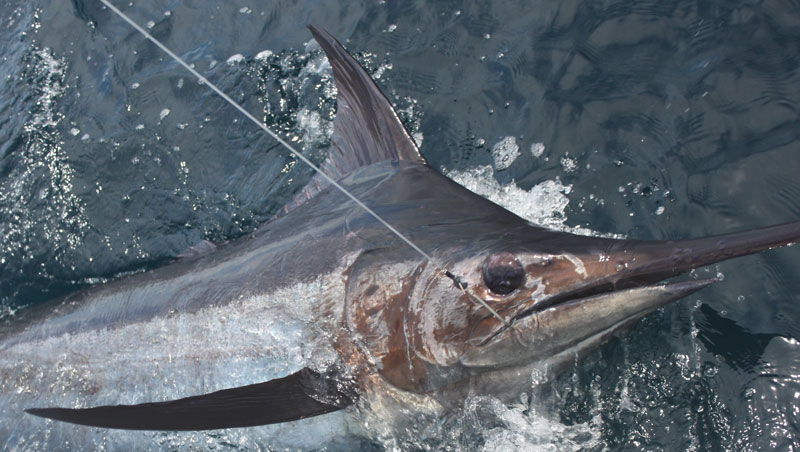If you think you're a decent billfish angler or consider yourself a lucky fisherman, then two tournaments are coming up this month that you may want to consider entering: the White Marlin Open and the Mid-Atlantic. They are among the most prestigious billfish tournaments in the world, take place in our own back yard, and offer some of the biggest payouts in the world of fishing. Catch the winning white or blue marlin and it's like matching all the numbers in the lottery – prizes well over the $1,000,000.00 mark are possible. (In fact, the Mid-Atlantic used to be called the Mid-Atlantic $500,00 but they had to change the name to keep up with the prize money, and last year this tournament paid out two prizes over a million and three more in the half-million dollar range!)

Yup, that's a lot of zeros. The best crew member on any team is Lady Luck, and she has probably accounted for more tournament winning fish then all the skill combined. Unbelievable stories abound about how winning fish were caught. One year a crew gave up all hope and was in the salon playing poker when a white committed suicide and hooked itself on one of the lines. Another year the crew only caught one marlin during the entire tournament… but it was the right one. However, since Lady Luck cannot always be counted on to show up in your cockpit, here are a few tips to keep in mind to try and win the old fashion way – with skill.
Big Money Tournament Tips
First and foremost, tournament fishing requires some sleep, a tough chore with all the evening celebrations at these events. Anglers need to be well rested and bring their A-game. Paying careful attention to what's being dragged behind the transom is required all day. Billfish appear when least expected, and the crew must be ready to react.
Six or more lines behind the boat can become confusing when someone shouts out "there's a bill." So point at the fish to save fractions of precious seconds. While one angler freespools and attempts to set the hook, the rest of the crew should pick up the remaining rods and focus all attention on their baits. Often a marlin quickly (as in the blink on an eye) switches to a different bait, and the most must be made out of every opportunity. So pay attention, pay attention, pay attention. Many teams assign an angler to each rod, to watch that individual bait. Others use a team concept to observe. Either way, the bottom line is: no napping, no slacking.
The importance of teasers and dredges cannot be over emphasized, especially when considering small boat billfish tactics. They raise billfish, as well as other species, period. Dredges made of imitation rubber baitfish or mylar strips with holograms of reflective fish are both good at raising fish. The only maintenance required is washing them down after each use and replacing missing strips or baitfish snatched off by some hungry pelagic. The charter fleet normally builds their own dredges for tournament fishing, rigging them with natural ballyhoo or mullet. Or use a combination of rubber and natural bait, which saves a few bucks. The combined dredge is rigged by using natural bait on the perimeter with rubber in the middle of the dredge. A natural bait dredge normally has a life span of one day of trolling, although baits not washed-out can be salted down for another use. It takes a little time to rig a ballyhoo or mullet dredge, but the time, effort, and expense is worth it. Dredges can be made any size with single, double or even triple dredge bars holding anywhere from eight to dozens of baits, but keep in mind, bigger is better. Dragging two dredges and utilizing two teasers (black/purple is at or near the top of the teaser color list) is the standard when setting a spread. At least one pitch rod should be rigged and within hands reach in the pit, to execute the bait and switch on any billfish that comes in hot on a teaser.
Although the majority of the baits behind transoms are naked and skirted ballyhoo targeting marlin, since both these tournaments pay out big money in the tuna division, some boats elect to pull a spreader bar or two. Normally mixed in the spread is at least one large bait, with blue marlin in mind. This line is typically pulled off a short rigger with an 80- or 130-class outfit. The bait is often a mackerel, mullet, large squid, or artificial lure.

Bait quality is extremely important. When picking baits out make sure the eyes are clear and frozen in good condition; no freezer burn. Artificial lures are used as well, but tournament history says the smart money is to bet on rigged natural baits when it comes to hanging a winning fish on the scale.
The White Marlin Open
The White Marlin Open is advertised as the premier fishing tournament of the world, and while that’s quite a claim, few would dispute it. The tournament is held out of Harbour Island Marina,14th Street and the Bay in Ocean City, MD. Boats fish three of five days between Monday and Friday.
The Mid-Atlantic
The Mid-Atlantic is held out of Cape May, NJ, at Canyon Club Marina, but has a headquarters/weigh station in Ocean City, MD at Sunset Marina. Anglers fish three of the five days.
- By John Unkart
For additional billfish tactics check out John Unkart's books, “Offshore Pursuit” and “Saltwater Tales”.
Editor's note: This article was originally published in July of 2019 and was last updated on May 9, 2024.